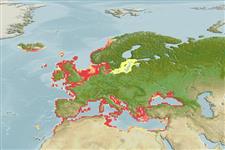| Native range |

|
| Scophthalmus rhombus AquaMaps Data sources: GBIF OBIS |
Length at first maturity
Lm ?, range 33 - 41 cm
Human uses
मात्स्यिकी: व्यापारिक; आखेट मत्स्य: हां
Phylogenetic diversity index
(Ref. 82805)
PD50 = 0.5645 many relatives (e.g. carps) 0.5 - 2.0 few relatives (e.g. lungfishes)
Trophic Level
(Ref. 69278)
4.4 ±0.1 se; Based on diet studies.
लौटाव
(Ref. 69278)
माध्यम, न्यूनतम जनसंख्या दुगनी होने का समय 1.4 - 4.4 वर्ष। (tm=-5; tmax=6)